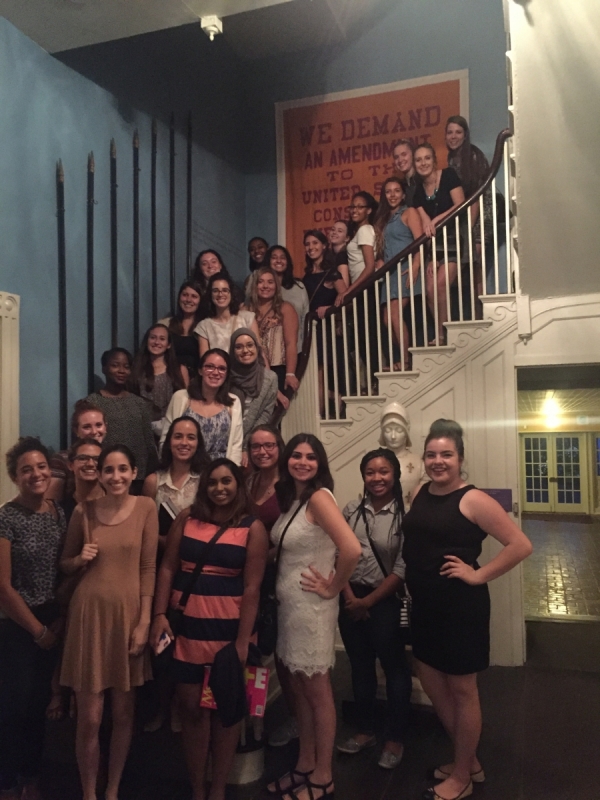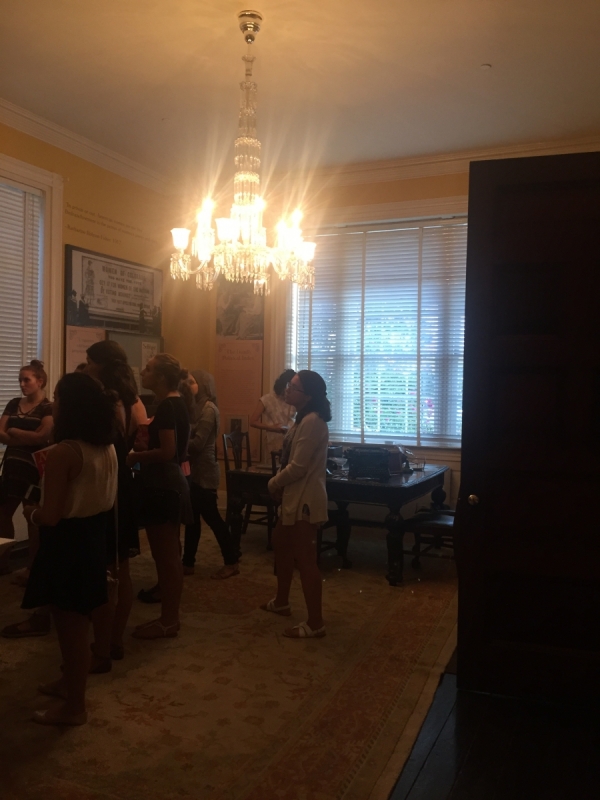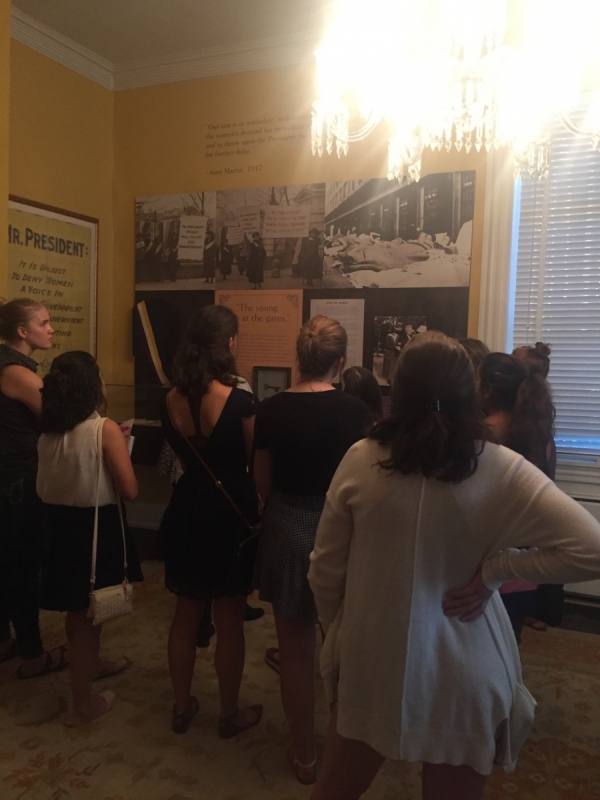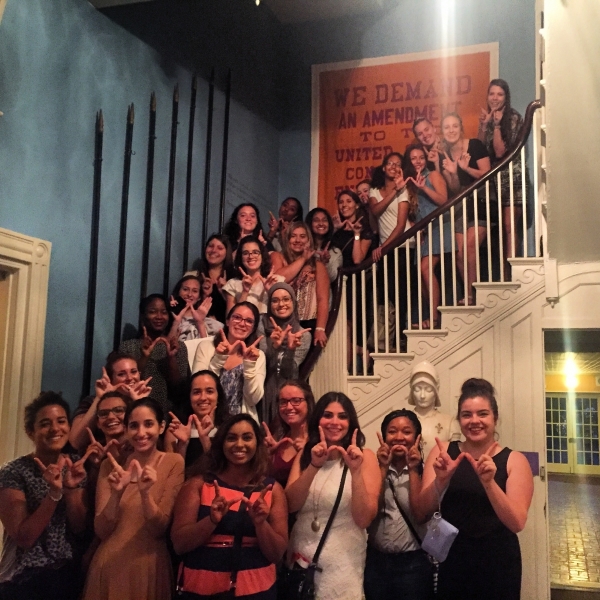On Thursday, September 8, the International Politics cohort enjoyed a private tour of the newly designated Belmont-Paul Women’s Equality National Monument, the museum that tells the story of the National Women’s Party. Some of our students share their thoughts on the visit in this series of blog entries.
“Forward out of darkness, leave behind the night. Forward out of error, forward into light.” Walking up the stairs of the Sewall-Belmont House, I thought of all of the brave women that had climbed up those stairs before me, and the one’s to come. A blaze of orange hit the stained glass windows as the sun set. We stood quite literally in the darkness. The sun would rise tomorrow and bring new hope to the world and in the same way, the women’s movement follows this cycle. There is still so much to fight for. White women still only make 77 cents to every dollar a man makes and women of color significantly less. Women have fought for over a hundred years and gained little since suffrage. Susan B. Anthony sat at her desk in the Sewall-Belmont house pondering problems that are shockingly similar to the problems my WLP sisters and I stay up late talking about. How can we be taken seriously by men? Why is half of the population not represented in government? Why do they keep asking me when I will find a boyfriend? Although a hundred years has passed, we are still asking these questions.
Alice Park said that “Feminism is as broad and definite as we make it… Political freedom-- simply permission to vote-- is a very tiny part of freedom. And we want all there is.” Feminism is a hot topic that a lot of people try to avoid. Absolute equality-- women with power is something that scares people. It is hard for a patriarchal society to imagine a new demographic in the work for and in the supreme court. It isn’t anyone’s fault that so many hesitate to identify themselves as feminists. It’s the way our brains have been trained by the media from a young age. Alas, change will come and we must push it forward so that maybe in one-hundred years when a new set of women walks up the stairs of the Sewall-Belmont house, the will learn about the girls of the Women’s Leadership Program and how they changed the course of history and of equality. They will stand in front of the same mirror upstairs and say to themselves “I will run for office”.
- McKinley Hall

"Situated right around the corner from Capitol Hill, the unassuming brick exterior of the Sewall-Belmont House and Museum gave no indication of the powerful artifacts of history it held. Unimposing and half-hidden by greenery, it was the sort of place one stumbled upon rather than found. Walking into the small foyer of the place that had been the headquarters of the National Women’s Party, we were greeted by our friendly tour guides and copies of Ms. Magazine neatly stacked on a table. As we made our way into the main hallway, we began to see some indication that this was a place of note. White ceramic busts of prominent female suffragettes lined the hallway and the walls were covered in banners and quotes from the national suffrage movement. “Mr. President, what will you do for Women’s Suffrage?” inquired a large cloth banner on our left. On our right were framed political cartoons from the famous artist and suffragette, Nina Allender. While we were admiring our surroundings, our tour guide began telling us about the history of the suffrage movement. Covering topics from the work of Alice Paul to the ratification of the 19th Amendment, she began instilling in us a sense of awe and admiration for the work that the women who had come before had done. As we learned about the imprisonment and harsh treatment of those who had worked toward suffrage we all started asking ourselves the same questions: did we have the courage that these women had? Would we choose to risk it all to fight for justice if given the opportunity to do so? As girls in the Women’s Leadership Program we knew that these questions were not merely hypotheticals but most likely would be real internal conflicts we would have to face in our lives. Taking the first step toward finding the answers to these questions in a house filled with so many examples of courage was an experience like no other. After we finished our tour of the museum we headed out to Union Station to grab some dinner. “We should be suffragettes for Halloween!” someone joked. The rest of laughed and readily agreed to sport the purple, white, and yellow suffragette sash on October 31st. At Union Station we reflected on our experiences both in WLP and at the museum, talking and laughing about our classes and the Sewall-Belmont House with our Graduate Teaching Assistant. All of us knew that it had been an experience to remember."
- Swetha Ramesh

"One of the most interesting parts of being in a group of diverse, intelligent women is that we all see the world through different lenses. Though we may be similar in many ways, we all experienced the Belmont-Paul Women's Equality National Monument differently. I thought the house was beautiful and I loved to see artifacts from the National Women’s Party and powerful quotes up on the walls. But I was able to focus on these things because I saw myself represented in the brave women of that party; my friends in WLP who are members of minority groups did not have the same privilege.
As soon as our tour guide was asked about the involvement of black women in the Women’s Party, it became clear that this large group of women had been completely brushed over. I don’t know how much that took away from their power or, upon reflection, how much it detracts from their authenticity and impressiveness, but it is clear in today’s modern world that you can not be a feminist without being an intersectional feminist. I am so grateful for how brave and bold these women were, but seeing the looks of resigned disappointment on my friends’ faces made me wonder why they couldn’t have been just a little bit braver and a little bit bolder.
Aside from that, I loved being in a space that was unapologetically about women. Too often we temper our passions and censor our thoughts so that no one feels “attacked” or left out of women’s issues or movements- as if we ever had a say in being included in the rest of history’s movements, groups, or decisions. But the Belmont-Paul Monument is clearly determined to continue the mission of the Party that called it home by honoring their accomplishments and keeping up the fight; issues of Ms. magazine were available in the lobby, and many of the gift shop offerings were indicative of modern-day feminism.
There were a few banners and quotes up on the walls that really spoke to me: “The Young are at the Gates,” “Mr. President, What Will You Do for Women’s Suffrage?” “Mr. President, How Long Must Women Wait for Liberty.” These women were using the kind of poetry that comes out of rebellion to make their points, and I felt like I was standing with one foot in history and one foot in 2016. So much has changed since the days that the Sewell-Belmont House was used as the home of the National Women’s Party, and yet we still have so much to fight for. But if we include our minority sisters and use all that we have learned, it will be a tough battle to keep us down."
- Matilda Kreider






